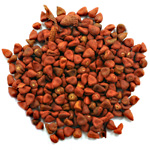  If you love sea bass, try it Brazilian style, in a stew flavored with annatto and chile.
If you love sea bass, try it Brazilian style, in a stew flavored with annatto and chile.
June 2007
|
 |
Recipe: Moqueca Capixaba, Brazilian Fish Stew
A Hearty Stew That Can Be Enjoyed Year-Round
This recipe is by Mara Salles, owner-chef of Tordesilhas restaurant in São Paulo, serving contemporary Brazilian cuisine. This hearty fish stew has an Indian influence, and includes annatto seeds for a deep, red color (more about them below). While you’ll need annatto powder for this recipe, if you don’t have malagueta pepper or manioc, traditional Brazilian ingredients, you can substitute comparable ones.
Learn about umami.
Serves 5
Ingredients
- 2 pounds of fish (net weight, slices or fillets), preferably sea bass or other firm, white-fleshed fish (in Brazil, namorado is popular)
- 5 ripe tomatoes, each chopped into 8 pieces
- 2 medium onions, chopped in large cubes
- 50 ml of annatto oil (made from 1.5 ounces (50 ml) of olive oil + 1 teaspoon of crushed annatto seeds)
- 3 chopped garlic cloves
- 1/2 cup of water
- 1 pinch of finely minced, fresh dedo de moça pepper or other small, hot chile (see reference below)
- 1 pinch of black pepper
- A few drops of fresh lemon juice
- Salt and cilantro to taste
For The Fish Purée
- 1 pound (1/2 kg) fish scraps (head, tail and backbone)
- 1.5 ounces (50 ml) of olive oil
- 2 garlic cloves
- 1 bunch of cilantro, parsley and green onion
- 1/4 green pepper and 1/4 red pepper, roughly chopped
- 2 roughly-chopped tomatoes, de-seeded
- 1 onion
- 1 quart of water
- 1 pinch each of annatto powder, salt, black pepper and malagueta pepper (or hot chile powder) to taste
- Manioc flour to thicken
- A few drops of fresh lemon juice
Directions
- Season the fish with salt, lemon and peppers. In a clay pan, heat the annatto oil and fry the garlic.
- Cover the bottom of the pan with the fish slices, add the chopped tomato and onion and pour in the water. Drizzle over a small amount of annatto oil.
- Cover and boil over a medium heat for 10 to 15 minutes, making sure that the vegetables remain whole and firm. Sprinkle with chopped cilantro and serve the dish while still piping hot.
To Make The Annatto Oil
- Heat the olive oil mixed with annatto seeds in a pan or frying pan, and stir until the oil takes on a reddish tinge.
To Make The Fish Purée
-
Season the fish with salt, lemon and black pepper. Fry the garlic in olive oil, then the tomatoes, pepper and onion. When cooked, add the annatto oil.
-
Add the fish and cook for about 10 minutes. Add the water and bunch of cilantro, parsley and green onion. Cook until the liquid is reduced to approximately 1 quart.
-
Strain the mixture, then place back on the heat, and adjust the seasoning with salt and malagueta pepper. When the mixture boils, add sufficient manioc flour so that it attains the consistency of a purée.
Information About The Ingredients
-
Annatto. Annatto, also called urucum, is a derivative of the achiote trees found  in tropical regions of the Americas. It is commonly found in Latin American and Caribbean cuisines as a coloring agent and for flavoring. The indigenous peoples of Central and South America used the seeds to make body paint and lipstick. In Brazil, powdered annatto is known as colorau and is used as red food coloring.
They can be found at any spice store or Latin food market. The seeds in the photo are available from FrontierHerb.com.
- Dedo de Moça Pepper. Dedo de moça, or young lady’s finger, is the popular name for Capsicum baccatum var. pendulum, or Brazilian aji. The plant bearing very small and very hot oblong red chile peppers. The term includes wild forms native to tropical America, which are thought to be the forerunner of today’s sweet pepper and many hot peppers.
Brazilians cook with some very hot chiles: When making this recipe, substitute peppers at the heat level that you are comfortable with.
Recipe © Umami Information Center, UmamiInfo.com. Other material © Copyright 2005-
Lifestyle Direct, Inc. All rights reserved. Images are the copyright of their respective owners.

|





 in tropical regions of the Americas. It is commonly found in Latin American and Caribbean cuisines as a coloring agent and for flavoring. The indigenous peoples of Central and South America used the seeds to make body paint and lipstick. In Brazil, powdered annatto is known as colorau and is used as red food coloring.
They can be found at any spice store or Latin food market. The seeds in the photo are available from FrontierHerb.com.
in tropical regions of the Americas. It is commonly found in Latin American and Caribbean cuisines as a coloring agent and for flavoring. The indigenous peoples of Central and South America used the seeds to make body paint and lipstick. In Brazil, powdered annatto is known as colorau and is used as red food coloring.
They can be found at any spice store or Latin food market. The seeds in the photo are available from FrontierHerb.com.